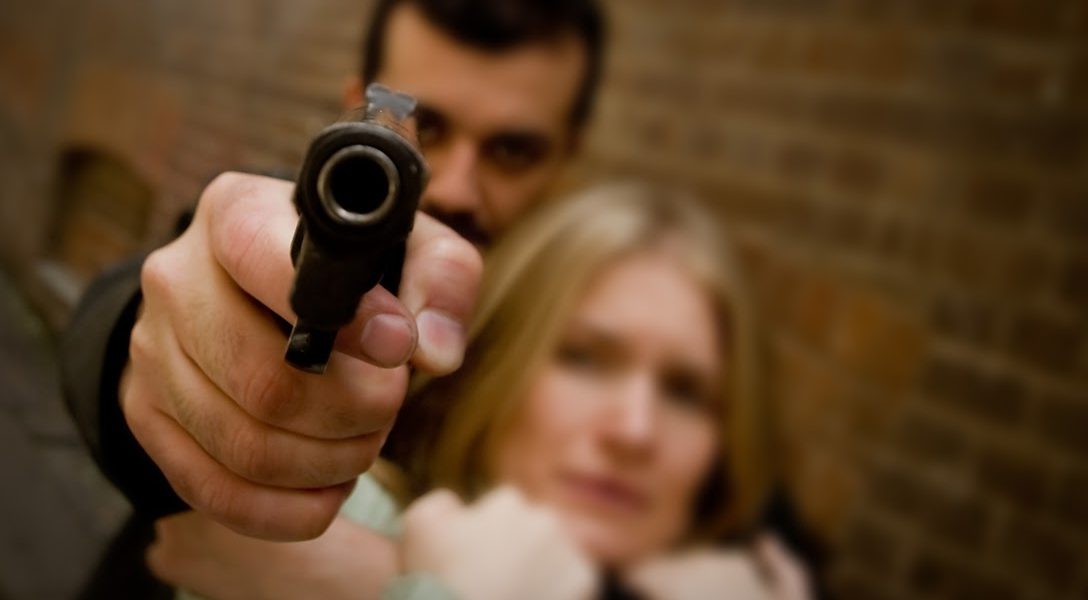Victim advocates worry that isolation, a rise in firearm sales, and a decreased law enforcement presence may cause a surge in domestic abuse and gun violence.

Every month, about 52 women in the US are shot and killed by their partners. But that figure was compiled under “normal” circumstances, before the coronavirus took hold of the country. With stay-at-home orders in effect, what is happening to women trapped all day under the same roof with their abusers? Will home become a pressure cooker with a tightly closed lid? And if circumstances turn up the heat, what then?
As growing numbers of police officers are quarantined and 911 call centers deal with a record-breaking volume of calls, law enforcement may be less available to respond to incidents of domestic violence.
“Abusers will use any tactic they can, particularly when they have access to a victim. I wouldn’t be a bit surprised if [the US] did see an increase or rise of use of firearms.”
“I can almost predict there’s going to be an upsurge in gun violence, especially with this trend of new gun buyers bringing guns into the homes,” Dave Keck, director of the National Resource Center on Domestic Violence and Firearms at Battered Women’s Justice Project, told WhoWhatWhy.
“Domestic violence is about power control,” he added. “And whenever anything bad happens, there’s a certain population that bears the brunt of it; it’s mostly women in controlling relationships.”
It has been a little over a month since the quarantines began, but crime reports for this time indicate that, though overall crime rates have dropped, gun violence rates have remained steady or even risen. In many cities, reports of domestic violence have also gone up.
These combined increases lead Keck and Ruth Glenn, another expert on domestic violence, to conclude that more people are likely to be shot in their own homes.
“Abusers will use any tactic they can, particularly when they have access to a victim,” said Glenn, CEO at the National Coalition Against Domestic Violence. “I wouldn’t be a bit surprised if [the US] did see an increase or rise of use of firearms.”
There are multiple factors that lead experts to believe shootings in domestic settings will rise. Guns are the most commonly used weapon in US homicides, and Glenn and Keck are concerned about the rise in firearm hoarding. When the coronavirus began spreading, Americans rushed to purchase guns and ammo.
Not only is there an increase in gun purchasing, but gun sellers are also reporting a large number of first-time firearm buyers. Keck worries that many victims may not even know that their abusers have acquired a gun.
Another contributing factor is that people have been forced into tighter spaces with their abusers. Lockdowns have already increased domestic violence in China, with a similar effect expected in the US.
Although Glenn does not believe that many new abusers will emerge from the lockdowns, she does think the existing ones may have more opportunities to do harm in isolation. According to Everytown For Gun Safety, when abusive partners have access to firearms, they are five times more likely to kill their female victims.
Solutions to address domestic violence are limited during the best of times; they are especially difficult to implement during this period of minimal social contact.
Women are often told to leave their abusive relationships; even under normal circumstances this may not feel like a realistic option. Fear of infection and economic hardship make it even more difficult.
For example, a domestic-violence victim may avoid seeking shelter at her parents’ home so that she does not risk infecting them.
In other cases, abusers may make it financially impossible for their partners to leave, especially during this time when many have lost their sources of income.
Women sometimes stay in abusive relationships because of threats and intimidation. If a fight escalates, for example, the abuser may casually pick up his gun to “clean it.” Because this type of aggressive behavior is subtle, it will “probably not result in any action from the police,” said Keck. Furthermore, he continued, while these implicit threats are psychologically damaging and controlling, many victims may feel they have little legal recourse.
Battered Women’s Justice Project focuses on long-term solutions to reduce gun violence by working with law enforcement and the tort system to develop protocols for engaging with and protecting survivors of domestic violence. But the organization’s progress could be set back by the pandemic, explained Keck. He said the legal system already disadvantages survivors, and the additional strain on law enforcement during the pandemic will likely divert resources which were already limited.
A Recipe for Disaster: Letting Domestic Abusers Keep Their Guns
Keck fears police officers will be more reluctant to make arrests during the pandemic. Many departments have already begun limiting arrests for low-level crimes in order to minimize their own exposure to infection and avoid bringing the coronavirus into jails.
Glenn hopes that police will remain engaged in addressing incidents of domestic violence and wants women to reach out to officers if they feel unsafe.
“No matter what’s going on in the world,” Glenn told WhoWhatWhy, “I think a survivor will know when to call 911.”
As a survivor, Glenn encourages others to use the resourcefulness they have learned through previous hardships during this challenging time; she knows that these women have many strategies up their sleeves.
“The reason we’re survivors is because we’ve been creative and resilient,” Glenn said. “And because of the abuser, we’ve had to assess our safety constantly. Don’t forget that even with COVID-19, your safety plan is in your head, and if you don’t have one, work with someone who can help.”
Related front page panorama photo credit: Adapted by WhoWhatWhy from Mark Mathosian / Flickr (CC BY-NC-SA 2.0) and Christin Bela / Flickr CC BY-NC-SA 2.0).



